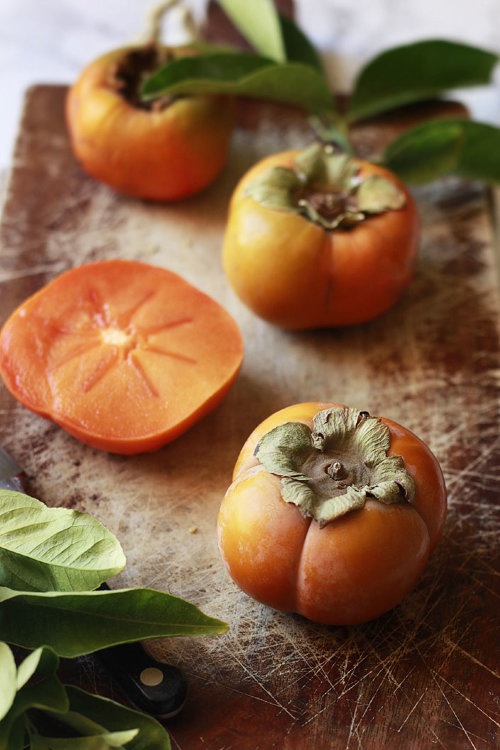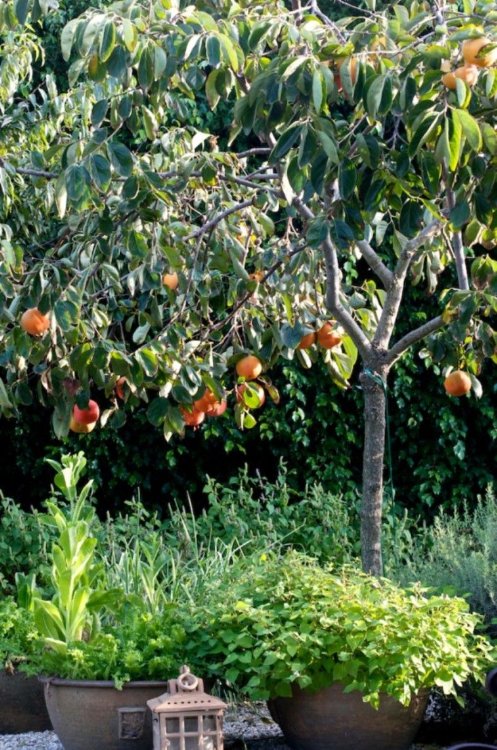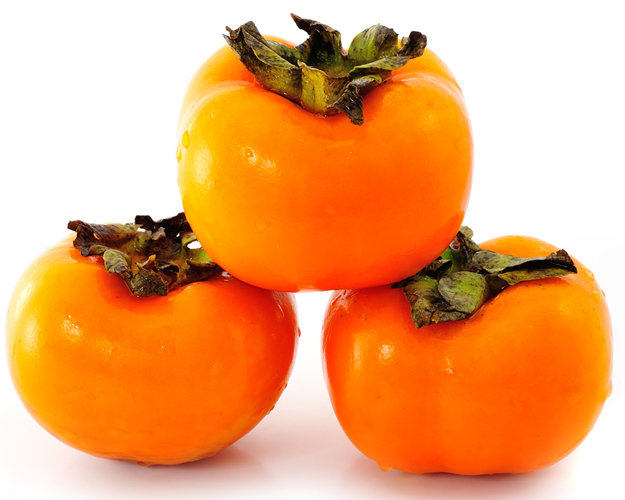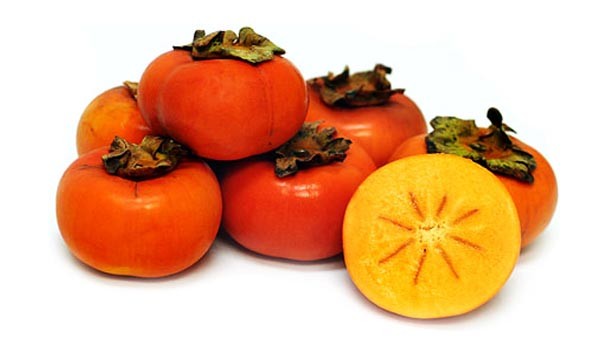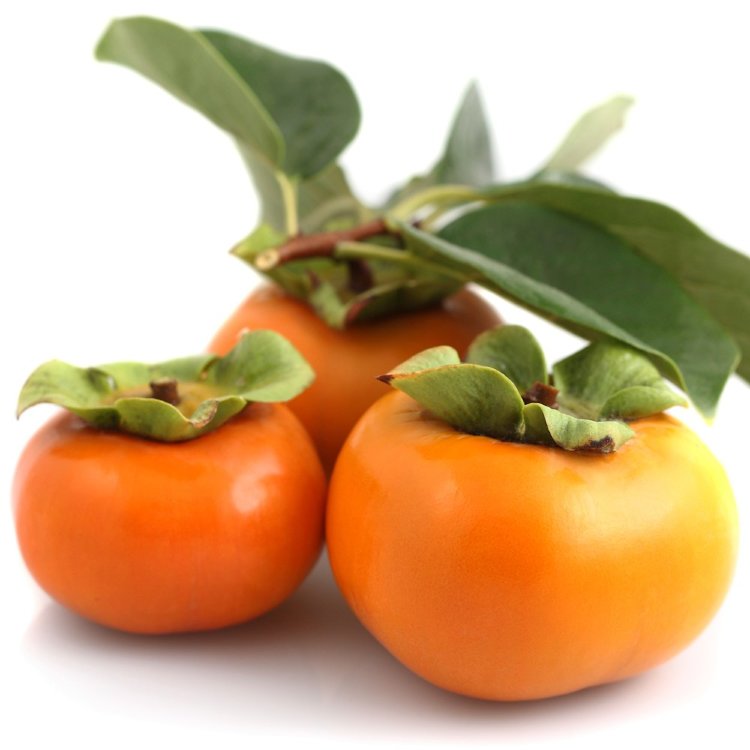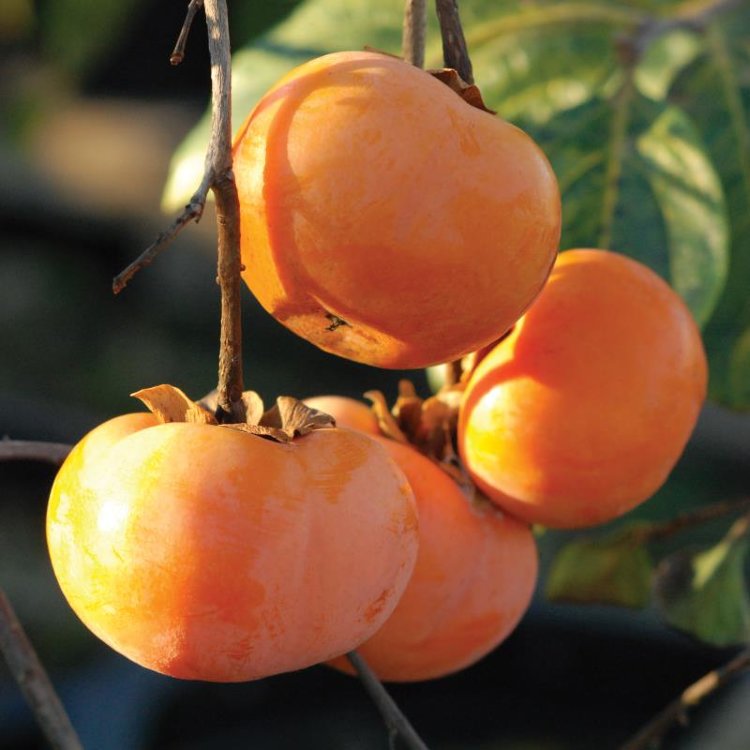- Overview
Common name: Persimmon Botanical name: Diospyros kaki Family: Ebenaceae Origin: Asia Avg. Height: 15-25 Feet Persimmon Tree Fuyu Variety Grafted in a 3 Gallon Container. This is the flat shaped fruit. The persimmon is a multitrunked or single-stemmed deciduous tree to 25 ft. high and at least as wide. It is a handsome ornamental with drooping leaves and branches that give it a languid, rather tropical appearance. . The color of the fruit varies from light yellow-orange to dark orange-red. The size can be as little as a few ounces to more than a pound. The entire fruit is edible except for the seed. Makes a great treat and is cold hardy will provide tropical tastes in cooler climates.
Description
Origin and Distribution
Pollination
Climate
Soil
Propagation
Culture
Cropping and Yield
Curing
Keeping Quality and Storage
Pests and Diseases
Food Uses
Food Value
Other Uses
Medicinal UsesA Persimmon is any of a number of species of trees of the genus Diospyros, and the edible fruit borne by them. The word persimmon is derived from putchamin, pasiminan, or pessamin, from an Algonquian language of the eastern United States, meaning "a dry fruit". Persimmons are generally light yellow-orange to dark red-orange in color, and depending on the species, vary in size from 1.5-9 cm (0.5-4 in) diameter, and may be spherical, acorn-, or pumpkin-shaped. The calyx often remains attached to the fruit after harvesting, but becomes easier to remove as it ripens. They are high in glucose, with a balanced protein profile, and possess various medicinal and chemical uses.
In great contrast to the native American persimmon, Diospyros virginiana L., which has never advanced beyond the status of a minor fruit, an oriental member of the family Ebenaceae, D. kaki L. f ., is prominent in horticulture. Perhaps best-known in America as the Japanese, or Oriental, persimmon, it is also called kaki (in Spanish, caqui), Chinese plum or, when dried, Chinese fig.
Description
The tree, reaching 15 to 60 ft (4.5-18 m) is long-lived and typically round-topped, fairly open, erect or semi-erect, sometimes crooked or willowy; seldom with a spread of more than 15 to 20 ft (4.5-6 m). The leaves are deciduous, alternate, with brown-hairy petioles 3/4 in (2 cm) long; are ovate-elliptic, oblong-ovate, or obovate, 3 to 10 in (7.5-25 cm) long, 2 to 4 in (5-10 cm) wide, leathery, glossy on the upper surface, brown-silky beneath; bluish-green, turning in the fall to rich yellow, orange or red. Male and female flowers are usually borne on separate trees; sometimes perfect or female flowers are found on male trees, and occasionally male flowers on female trees. Male flowers, in groups of 3 in the leaf axils, have 4-parted calyx and corolla and 24 stamens in 2 rows. Female flowers, solitary, have a large leaflike calyx, a 4-parted, pale-yellow corolla, 8 undeveloped stamens and oblate or rounded ovary bearing the style and stigma. Perfect flowers are intermediate between the two. The fruit, capped by the persistent calyx, may be round, conical, oblate, or nearly square, has thin, smooth, glossy, yellow, orange, red or brownish-red skin, yellow, orange, or dark-brown, juicy, gelatinous flesh, seedless or containing 4 to 8 flat, oblong, brown seeds 3/4 in (2 cm) long. Generally, the flesh is bitter and astringent until fully ripe, when it becomes soft, sweet and pleasant, but dark-fleshed types may be non-astringent, crisp, sweet and edible even before full ripening.
Origin and Distribution
The tree is native to Japan, China, Burma and the Himalayas and Khasi Hills of northern India. In China it is found wild at altitudes up to 6,000-8,000 ft (1,830-2,500 m) and it is cultivated from Manchuria southward to Kwangtung. Early in the 14th Century, Marco Polo recorded the Chinese trade in persimmons. Korea has long-established ceremonies that feature the persimmon. Culture in India began in the Nilgiris. The tree has been grown for a long time in North Vietnam, in the mountains of Indonesia above 3,500 ft (1,000 m) and in the Philippines. It was introduced into Queensland, Australia, about 1885. It has been cultivated on the Mediterranean coast of France, Italy, and other European countries, and in southern Russia and Algeria for more than a century. The first trees were introduced into Palestine in 1912 and others were later brought in from Sicily and America. Seeds first reached the United States in 1856 when they were sent from Japan by Commodore Perry. Grafted trees were imported in 1870 by the U.S. Department of Agriculture and distributed to California and the southern states. Other importations were made by private interests until 1919. Seeds, cuttings, budwood and live trees of numerous types were brought into the United States at various times from 1911 to 1923 by government plant explorers and the tree has been found best adapted to central and southern California, Arizona, Texas, Louisiana, Mississippi, Georgia, Alabama, southeastern Virginia, and northern Florida. A few specimens have been grown in southern Maryland, eastern Tennessee, Illinois, Indiana, Pennsylvania, New York, Michigan and Oregon. By 1930, California had over 98,000 bearing trees and nearly 97,000 non-bearing, on 3,000 acres (1,214 ha). California production in 1965 amounted to 2,100 tons. Real estate development reduced persimmon groves to 540 acres by 1968. In 1970, California produced 1,600 tons–92% of the total U.S. crop. In parts of Central America, Japanese persimmons have been planted from sea-level to 5,000 ft (1,524 m). The tree was first grown in Brazil by Japanese immigrants. By 1961, the total crop was 2,271,046,000 fruits, mainly in the State of Ceará, followed by Pernambuco and Piaui, with Bahia far behind. At present, the largest orchards are mainly in the States of Sao Paulo, Parana and Rio Grande do Sul, with lesser groves in Minais Gerais and Espirtu Santo. Of 111,412 acres (45,088 ha) all told, 60,336 acres (24,418 ha) are in Ceará. Israel and Italy have developed commercial plantings, and cultivar trials began in 1976 with a view to establishing persimmon-growing for export in southeastern Queensland.
Pollination
Some cultivars in certain locations and under some conditions, will fruit abundantly without cross-pollination, but this trait is not dependable. In commercial groves, the cultivar known as 'Gailey', which regularly produces many male flowers, is interplanted to insure adequate pollination. The formula is one male for every 8 female trees, uniformly dispersed throughout the grove; or 12 to 24 pollinating trees per acre (30-60 per ha). Japanese farmers sometimes plant the pollinating trees as a hedge around the grove. If hand-pollination of early cultivars is necessary, unopened male buds are collected, dried, opened and the pollen separated and stored. When needed, it is mixed with skimmed milk or club moss (Lycopodium) and applied at 1/7 to 2/7 oz per acre (10-20 g per ha). If the flowers are not effectively pollinated, the entire crop of fruit may fall prematurely. This is a fault of the cultivar 'Isu' in Japan. Losses can be reduced by girdling the tree after flowering but the practice has the effect of retarding growth. If the weather is hot and dry at blooming time, pollination will be inadequate and very few fruits will be set. The maintenance of bee colonies (1 or 2 hives for every 2 1/2 acres, or per ha) in persimmon orchards will enhance pollination, especially in cultivar 'Fuyu'.
Climate
The Japanese persimmon needs a subtropical to mild-temperate climate. It will not fruit in tropical lowlands. In Brazil, the tree is considered suitable for all zones favorable to Citrus, but those zones with the coldest winters induce the highest yields. The atmosphere may range from semi-arid to one of high humidity. Trees in the Middle Atlantic States have been known to have withstood temperatures as low as 20º F (-6.67º C) and to have remained in excellent condition and fruitful after 40 years.
Soil
The tree is not particular as to soil, and does well on any moderately fertile land with deep friable subsoil. In Florida, a sandy loam with clay subsoil promotes good growth. While the young tree needs plentiful watering, good drainage is essential.
Propagation
Indonesians propagate the tree by means of root suckers. In the Orient, selected cultivars are raised from seed or grafted onto wild rootstocks of the same species, or onto the close relative, D. lotus L. In the eastern United States, the trees are grafted onto the native American persimmon, D. virginiana. This rootstock significantly contributes to cold-resistance. California growers have found D. kaki the most satisfactory rootstock, D. lotus rootstock resulting in much lower yields. Seeds for the production of rootstocks need no pretreatment. They are planted in seedbeds or directly in the nursery row 8 to 12 in (20-30 cm) apart with 3 to 3 1/2 ft (0.9-1.06 m) between the rows. After a season of growth, they may be whip-grafted close to the surface of the soil, using freshly cut scions or scions from dormant trees kept moist in sphagnum moss. Cleft-grafting is preferred on larger stock and for top-working old trees. In India, cleft-grafting on stem has been 88.9% successful; while cleft-grafting on crown and tongue-grafting on stem have been 73.4% successful when the grafted plants were left for 2 weeks at about 77º F (25º C) and relative humidity of 75% for 2 weeks before planting. In the Kulu Valley, India, scions are grafted onto 2-year-old D. lotus seedlings which are mounded with earth to cover the graft until it begins to sprout. At the Fruit Research Station, Kandaghat, 2-year-old D. lotus seedlings were used as rootstock for veneer and tongue grafts from cv 'Hachiya' between late June and the third week of August. Success rates ranged from 80 to 100%. In Palestine, trees grafted on D. lotus and grown on light soil are dwarfish, fruit heavily at first, but are weak and short-lived. Those grafted on D. virginiana are larger and vigorous and bear heavily consistently. The only disadvantage is that the shallow root system fans out to 65 ft (20 m) from the base of the tree and wherever the roots are injured by cultivation, suckers spring up and become a nuisance.
Culture
The soil should be well prepared–deeply plowed and enriched with organic matter. Trees should be set out at spacings ranging from 15 x 5 ft (4.5 x l.5 m) to 20 x 20 ft (6 x 6 m), depending on the habit of the cultivar. In Japan, 404.7 plants per acre (1,000 per ha) may be installed at the outset, to be thinned down to 85 trees per acre (200 per ha) in 10-15 years. Good results have been obtained with a fertilizer mixture of 4 to 6% N, 8 to 10% P and 3 to 6% K at the rate of 1 lb (.45 kg) per tree per year of age. Generally the application is made in spring, but some growers apply half in the spring, half in July. Over-fertilization or excessive amounts of nitrogen fertilizers will cause shedding of fruits. Young trees are pruned back to 2 1/2 ft to 3 ft (.74-.91 m) when planted and later the new shoots are thinned with a view to forming a well-shaped tree. Some cultivars tend to develop a willowy growth and require cutting back occasionally to avoid the development of weak branches which break when heavy with fruit. Annual pruning during the first 4 to 5 winters is desirable in some cultivars. If a tree tends to overbear and shows signs of decline, it should be drastically cut back to give it a fresh start. After flowering, the trees should be irrigated every 3 weeks on light soil, every month on heavier soil, until time for harvest. One California grower, with trees on deep river loam, has provided furrow irrigation every 2 weeks from April through September. Branches are fragile and must be propped when heavily laden with fruits.
Cropping And Yield
rn Many cultivars begin to bear 3-4 years after planting out; others after 5-6 years. Shedding of many blossoms, immature and nearly mature fruits is characteristic of the Japanese persimmon as well as the tendency toward alternate bearing. The annual yield of a young tree ranges from 50 to 96 lbs (22.6-40.8 kg); of a full-grown tree, 330 to 550 lbs (150-250 kg). Estimated yield in Brazil is 6.5 tons per acre (15 tons per ha), but yields will vary with the cultivar and cultural practices. Harvesting takes place in fall and early winter. Late ripening cultivars may be picked after hard frosts or light-snowfall. Japan produces about 300,000 tons per year. Japanese growers use color charts to determine when each cultivar is ready for harvest. Astringent cultivars are picked when fully mature but hard and are cured before marketing.
Curing
In the Orient, much of the crop is left in piles covered by bamboo mats to cure (near-freeze) naturally and is marketed throughout the winter. In some parts of China, the fruit is cured in covered pits by introducing the smoke from burning dung. There are several other methods of curing: soaking in vinegar or immersing in boiling water and letting stand for 12 hours. 'Hachiya' fruits kept in warm water –104º F (40º C)–for 24 hours will be firm and non-astringent 2 days after treatment. One practice is to leave the astringent fruits in lime water for 2 days but tests have shown no advantage of a lime solution over pure water except that lime disinfects and can prevent the rotting that might follow soaking. In Japan, the fruits may be sprayed with ethanol, or stored for 10 days to 2 weeks in kegs which previously contained sake; or they may be stored in air-tight containers with ethylene gas for 3 days. Carbon dioxide is widely employed and the treatment consists of storing in a 95% CO2 atmosphere for 24 hours at 68º to 77º F (20º-25º C), but the fruit softens very quickly thereafter. In Brazil, successful curing has been achieved by immersing 'Taubate' persimmons in 1,000 ppm solution of ethephon (an ethylene generator) for 1 hour and then storing at room temperature for 4 days. Large quantities are cured by exposure to the fumes of alcohol (aguardiente), acetylene gas from combustion of calcium carbonate, or gas from burning sawdust, in hermetically sealed chambers at temperatures between 68º and 82.4º F (20º and 28º C) at relative humidity of 80%. Various other chemical processes and gamma radiation have been successfully employed in other countries. A simple method was discovered in California some years ago. The newly picked fruits were merely pierced once at the apex with a needle dipped in alcohol, then the fruits were layered with straw in a tightly closed box for 10 days. The homeowner may merely keep the fruits at room temperature in a closed vessel or plastic bag for 2-4 days with bananas, pears, tomatoes, apples, or other fruits which give off ethylene gas. In India, the persimmons are individually paper-wrapped and placed in alternate rows with 'Kieffer' pears in a closed container and are edible in 3 days. Non-astringent cultivars need no curing.
Keeping Quality and Storage
In California, persimmons are graded by size, then tissue-wrapped and packed in peach boxes for rail shipment in refrigerated cars. Packing in other areas is similar. Astringent types soften in 2 or 3 days after treatment and quickly become overripe. Non-astringent types are usually harder than astringent types when picked, and they therefore ship and keep better. Persimmons have been kept for 2 months at 30º F (-1.11º C) and 85-90% relative humidity. 'Triumph' is frequently stored in Israel for as long as 4 months at 30º F (-1.11º C). Persimmons have been kept in good condition for several months in sealed 0.06 mm polyethylene bags at 32º F (0º C). Spraying the bearing branches with gibberellic acid 3 days before harvest has retarded maturity on the tree; has doubled the storage life of astringent types after curing.
Pests and Diseases
In Brazil, premature fall of 'Fuyu' is partly linked to heavy infestation by the mite, Aceria diospyri. Spraying with Sevin 85 ppm 3 times at 30-day intervals right after petal fall controls the mite and increases yield. Retithrips syriacus feeds on and blemishes the leaves and fruit skin in Palestine but has been controlled by spraying with nicotine sulfate. The greenhouse thrips (Heliothrips haemorrhoidalis) blemishes fruits in Queensland. San José scale is combatted by a dormant application of Bordeaux in diesel emulsion in India. In Florida, white peach scale, Pseudaulacaspis pentagona, has required control and a twig girdler, Onsideres cingulatus, has been troublesome. Also, a flat-headed borer drills into the bark and the wood causing oozing of gum and decline in vigor. The main enemies in the eastern United States are mealybugs which distort young shoots and kill all new growth unless controlled. They do not seriously affect mature trees. In Brazil and Queensland, fruit flies may attack the fruits, especially in dry years. Tree-ripe persimmons are sought by all kinds of birds, especially by parrots and crows in India, where flying foxes are a nocturnal menace. The less astringent types seem to be preferred by all of these predators. Bird-repellent sprays have given good control in Queensland. There, sunburn affects marketability especially of 'Tanenashi' and 'Tsuru magri'. In India, low germination rates of planted seeds has been traced to dry rot caused by Penicillium sp. It can be controlled by pretreatment with an appropriate fungicide. D. lotus rootstock is subject to root rot and crown gall in Florida but resistant to wilt caused by Cephalosporium diospyri which induces severe defoliation and has killed trees on D. virginiana rootstock. In Brazil, Cercospora may spot the leaves, and a virus causes "mosaic"–mottling of leaves and premature leaf fall, shedding of flowers, and necrotic spots on fruits; also a different necrosis on the tree and the bark of shoots, twigs and branches that causes die-back. Anthracnose occurs on fruits that have slightly cracked or have been pierced by insects. In Florida, leaf spot, algal leaf spot, twig blight, twig dieback, root rot, thread blight and other fungal diseases may occur.
Food Uses
Fully ripe Japanese persimmons are usually eaten out-of-hand or cut in half and served with a spoon, preferably after chilling. Some people prefer to add lemon juice or cream and a little sugar. The flesh may be added to salads, blended with ice cream mix or yogurt, used in pancakess, cakes, gingerbread, cookies, gelatin desserts, puddings, mousse, or made into jam or marmalade. The pureed pulp can be blended with cream cheese, orange juice, honey and a pinch of salt to make an unusual dressing. Ripe fruits can be frozen whole or pulped and frozen in the home freezer. Large quantities of 'Tamopan' are preserved by drying. Drying is commonly practiced in Brazil and the dried fruit is popular throughout the country. Some California growers dry the 'Hachiya' by a Chinese method. The fruits are picked when mature but firm, are peeled and hung up by their stems for 30-50 days to dry in the sun. Kneading every 4-5 days is necessary to give uniform texture and improve flavor. Then they are taken down and sweated for 10 days in heaps under mats. Sugar crystals form on the surface. Lastly, they are hung up again to dry in the wind. In the Orient, the peelings are dried separately and are mixed in with fruits when packed for sale. An inferior product is made by slitting the skin with a knife, then spreading the fruits out on mats to dry for several weeks, then sweating them in piles, and the product is sold at a very low price. In Indonesia, ripe fruits are stewed until soft, then pressed flat and dried in the sun. Early travelers called such fruits "red figs". Intestinal compaction from consumption of persimmons in Israel has been eliminated by drying the fruits before marketing, and some dried fruits are now being exported to Europe. Surplus persimmons may be converted into molasses, cider, beer and wine. Roasted seeds have served as a coffee substitute.
Food Value Per 100 g of Edible Portion*
Calories 77
Moisture 78.6 g
Protein 0.7 g
Fat 0.4 g
Carbohydrates 19.6 g
Calcium 6 mg
Phosphorus 26 mg
Iron 0.3 mg
Sodium 6 mg
Potassium 174 mg
Magnesium 8 mg
Carotene 2,710 I.U.
Thiamine 0.03 mg
Riboflavin 0.02 mg
Niacin 0.1 mg
Ascorbic Acid 11 mg
*Average values.
The astringent substance in the persimmon, generally called "tannin", has been much studied and variously defined as knowledge of tannins and other phenols has unfolded. To put it simply, it is classed as a condensed tannin (proanthocyanidin) of complex structure.
One would be wise to eat only fully ripe persimmons from which the tannin has been almost entirely eliminated. The skin, which retains some tannin, should not be eaten.
Other Uses
Tannin from unripe Japanese persimmons has been employed in brewing sake, also in dyeing and as a wood preservative. Juice of small, inedible wild persimmons, crushed whole, calyx, seeds and all, is diluted with water and painted on paper or cloth as an insect- and moisture-repellent. The wood of the tree is fairly hard and heavy, black with streaks of orange-yellow, salmon, brown or gray; close-grained; takes a smooth finish and is prized in Japan for fancy inlays, though it has an unpleasant odor.
Medicinal Uses
A decoction of the calyx and fruit stem is sometimes taken to relieve hiccups, coughs and labored respiration. - Features
weight: 9.99 lbs : - ReviewsThere is no reviews yet...Be the first!
Be the first to write a review of this product!
